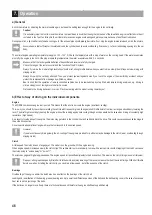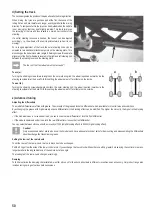
49
c) Setting the camber
The camber is the inclination of the wheels to the perpendicular.
Negative camber
Positive camber
(wheel top edges point inwards)
(wheel top edges point outwards)
A negative camber at the front wheels increases the cornering forces of the wheel when driving in bends, the steering responds more directly, the steering forces
are reduced. At the same time, the wheel is pushed onto the axle leg in the direction of the axis. This disables axial bearing clearance, the driving behaviour is
calmer.
A negative camber at the rear wheels reduces the tendency of the rear of the vehicle to swerve in curves. By setting a negative camber, the wear on the inside
of the tyres increases. However, this effect can be compensated by setting a toe-in.
Setting a positive camber reduces the cornering forces of the wheels!
Setting the camber at front and rear wheels
The straining screws used to fine-tune the camber are located in the
upper control arms.
• Turn the straining screw in the upper control arm clockwise: The wheel
top edge is pulled inwards towards a "negative camber".
• Turn the straining screw in the upper control arm anti-clockwise: The
wheel top edge is pulled outwards towards a "positive camber".
Make sure the settings for the cornering forces of the front and the rear
axle are well-balanced, as differences can cause "oversteering" or
"understeering" driving behaviour.
Summary of Contents for 23 68 22: RtR
Page 114: ...114 ...
Page 115: ...115 ...
















































